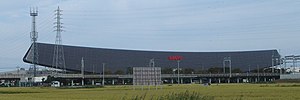Solar Ark

The Solar Ark inside Sanyo Electric Co., Ltd. Gifu Plant
|
|
| Established | 1 April 2002 |
|---|---|
| Location | 180 Ohmori, Anpachi, Gifu, 503-0195 Japan |
| Type | Science museum |
| Public transit access | JR Gifu-Hashima Station |
| Website | Solar Ark |
The Solar Ark (ソーラーアーク) is an ark-shaped solar photovoltaic power generation facility which offers activities to cultivate a better appreciation of solar power generation, and thereby benefitting both ecology and science. This 315-meter-wide, 37-meter-tall facility is located in Anpachi, Gifu Prefecture, in the geographical center of Japan, and can be seen from the JR Tōkaidō bullet train, which runs past on an adjacent railway. It has over 5000 panels that produce approximately 530,000 kilowatt-hours on an annual basis and a maximum system power of 630 kilowatts.
Stationed at the center of the Solar Ark is the Solar Lab, a museum of solar energy. A hands-on, outdoor light exhibition was planned for opening in 2005. The Solar Ark was an enterprise partner with the 2005 World Exhibition, Aichi Prefecture, Japan. It is one of the largest solar buildings in the world.
The Solar Ark was constructed by Sanyo Electric Co. Its development was accidental among other things. Initially, Sanyo Electric had intended to create the largest photovoltaic system in the world, with a 3.4 megawatt output, to mark the organisation's 50th anniversary. By 1998, designers had already been in discussions about the Solar Ark’s appearance. Sanyo had planned on using cutting edge solar technology available to them at the time, using a combination of crystal silicon and thin-film amorphous silicon with 14-15% efficiency. However, during the initial planning, Sanyo had to recall several monocrystalline cells, which were the predecessors of the hybrid technology mentioned before, due to insufficient output.
Sanyo Electric Co. still decided to go ahead with the Solar Ark’s construction; however, instead of using the previously planned technology, Sanyo instead, used the recalled monocrystalline cells. Sanyo says “We have done this to show our sincere regret that this problem has occurred and to express our willingness and determination to both remember what happened and how important it is to maintain quality.” Construction was completed in December 2001.
Panasonic acquired Sanyo, and as part of its corporate restructuring and re-branding strategy, the red Sanyo logo on the Solar Ark was replaced with a blue Panasonic logo in August 2011.
...
Wikipedia
